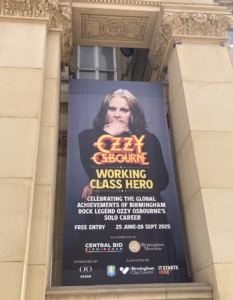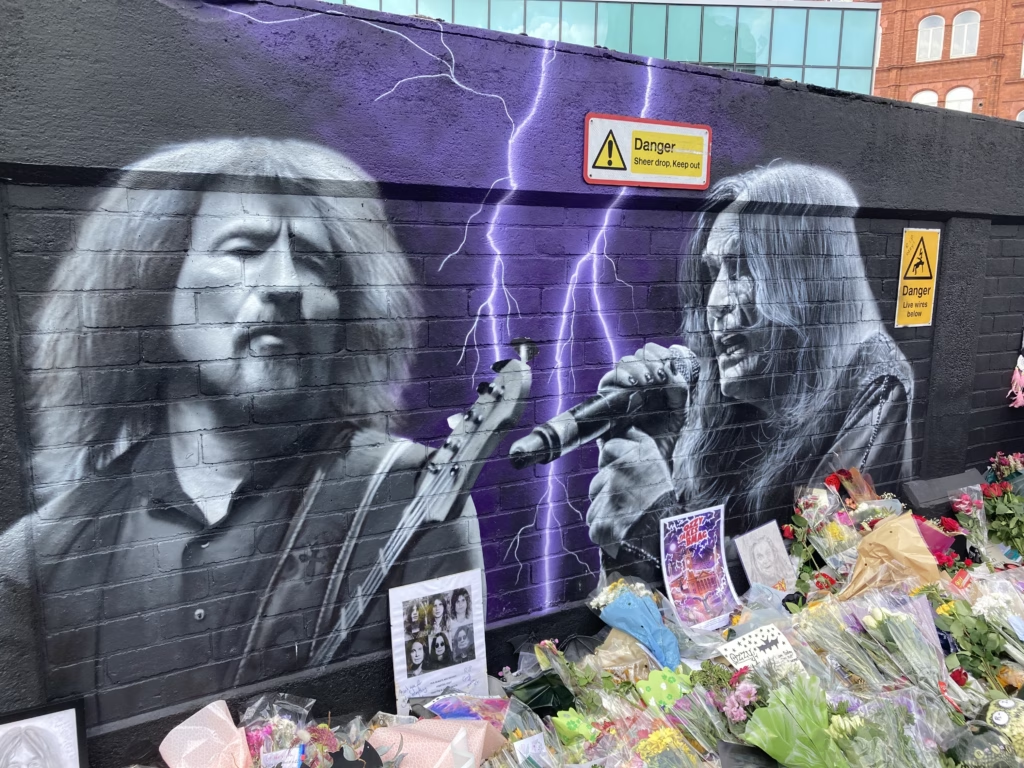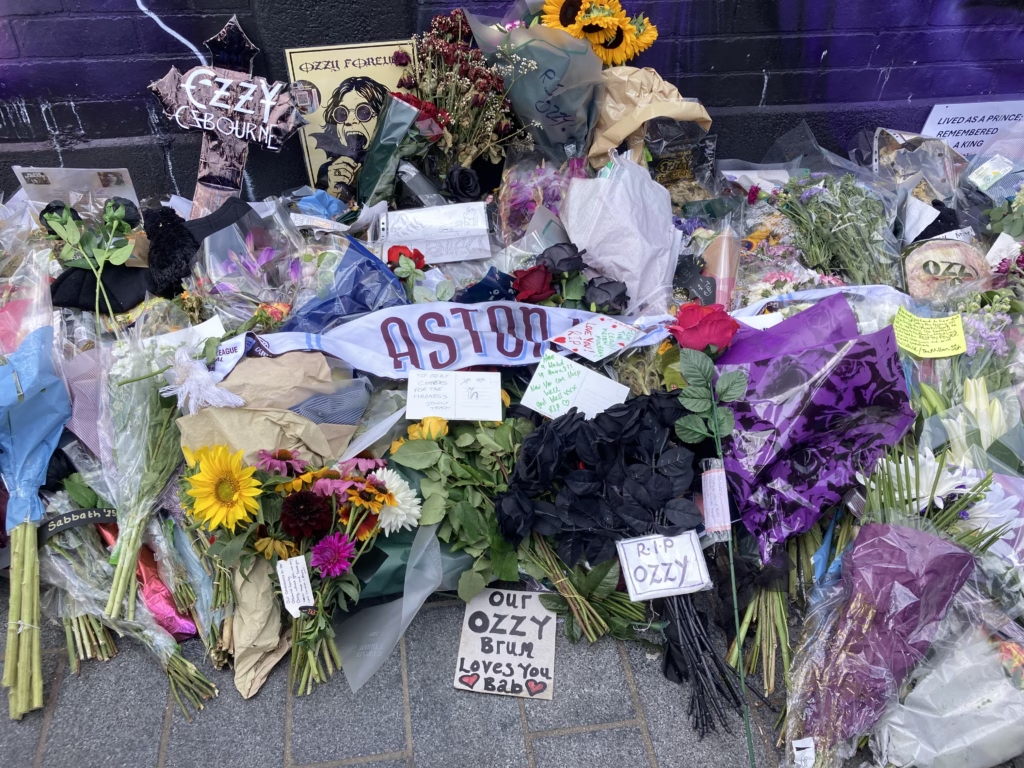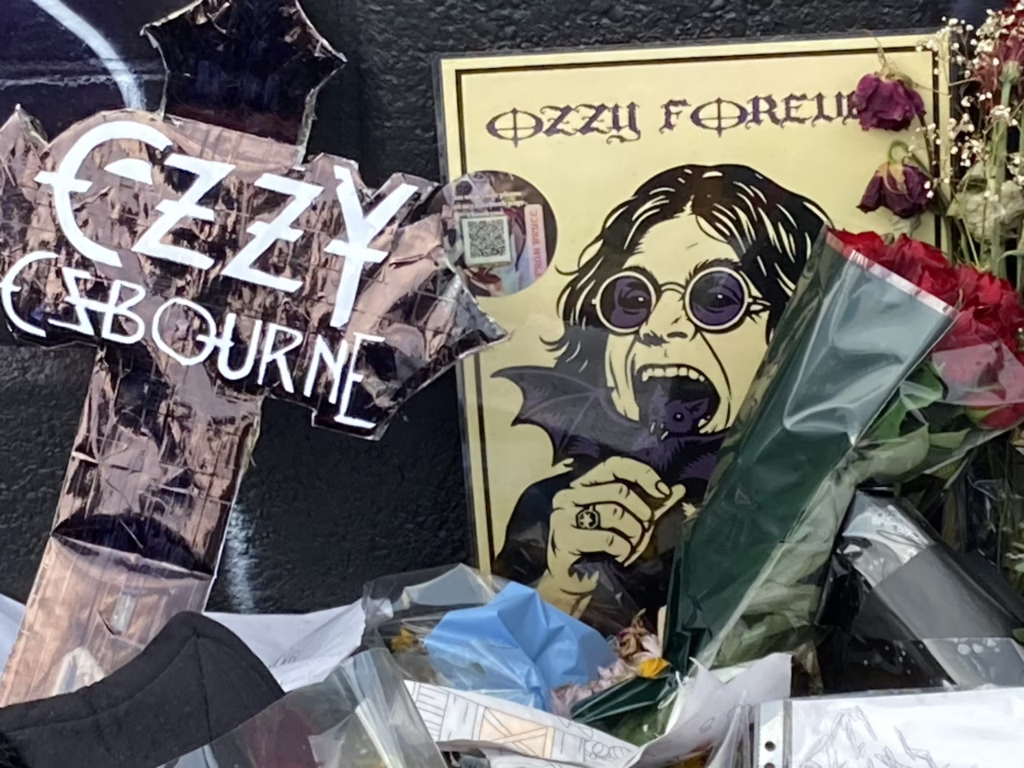I may be British, but I’m not one to get all worked up over royal weddings, state funerals, or jubilees. With that said, when it comes to our recently departed Prince of Darkness, Ozzy Osbourne—well, that’s another matter.
The heavy metal legend and cofounder of Black Sabbath passed on July 22 at the age of 76, just 17 days after his final showstopping performance in front of 45,000 fans at Villa Park. The music world spent the past week remembering one of the wildest, funniest, and most genuine artists ever to grace the stage. With just a day’s notice, it was announced that fans would have one last chance to say goodbye to Oz. His cortege was supposed to pass down Broad Street in his hometown of Birmingham, starting at 1 p.m. And it just so happened I was only a few hours away by coach ride. So with a mountain of black t-shirts in my wardrobe, I decided it was my solemn duty to represent.
My first stop was to the Birmingham Museum & Art Gallery. It was hosting Ozzy Osbourne (1948–2025): Working Class Hero, a tribute exhibition to Oz’s solo achievements and global accolades, timed to coincide with his recent historic homecoming concert. Now, the short but glitzy display of posters, gold records, and statuettes took on a more poignant tone.

A local school trip arrived to view the honors of the hometown hero, while a civic book of condolences sat just feet from the exhibition’s entrance. As I joined the queue to sign, it became clear that today would be a big deal. Fans from Italy and Germany stood alongside me, having flown in just last night for the chance to say goodbye. Ahead of me, a teenage cancer patient respectfully removed his beanie while writing his message. People of all ages, young and old, came pouring in, eager for a moment to simply say thanks. Some cried. Others sadly sighed and quietly left the gallery.
Following a sea of rock T-shirts north, I arrived at Broad Street, where Ozzy’s procession was set to pass. It would make a brief stop at Black Sabbath Bridge, where the Osbourne family planned to read condolences and lay flowers.
The crowd was immense. Tens of thousands of locals, fans, and curious onlookers lined the kilometer-long stretch. After an hour’s wait, a roar rose in the distance, soon joined by the sound of the local Bostin Brass Band playing some of the late singer’s greatest tunes. The moment felt surreal, and even more so when Ozzy’s hearse appeared moments later.
Some fans, myself included, were surprised that Ozzy’s final ride wasn’t by horse and carriage. It seemed like the showman’s choice, after all. Even so, the crowd applauded as the hearse—marked with a small purple cross and his name spelled out in purple flowers—rolled by.
The energy of the crowd wasn’t heavy with grief or melancholy, though. It was filled with quiet pride and joy—almost like a collective “You did well, kid.” The moment perfectly reflected the humble Brummie spirit. It was about showing up for one of their own, rock god or not. When the procession ended, hundreds gathered in Centenary Square to join the Bostin Brass Band for a dance and a cry as they played on.

If the sheer number of people, closed-off roads, and live-streamed coverage weren’t sign enough, a walk toward New Street Station made the scale of the goodbye undeniable. Every pub, café, and corner shop blasted tracks like “Paranoid,” “Into the Void,” and “Crazy Train.”
On Navigation Street, the newly created Black Sabbath mural—signed by all the band members just weeks ago—was surrounded by those leaving mementos. It was here, in the relative calm, with a nearby screen playing Ozzy’s ballad “Dreamer,” that I felt a tear well up. The messages, the thanks, and the song created a powerful combination I couldn’t ignore.
Amid all the wild antics, dirty jokes, and side-splitting honesty, it’s easy to forget that Ozzy was the spokesperson for misfits—the original, the one who gave an entirely new genre of music its voice. By his own admission, he wasn’t a remarkable musician, but Ozzy possessed a truly singular howl and an uncanny knack for vocal melodies. His stage presence and fuck-you energy embodied the true spirit of metal.
Forged in the grime of postwar Britain as a middle finger to the hippie movement, metal needed a wildcard, and Ozzy was the one who helped sell that strange, doom-laden aura. Formed in 1968, Black Sabbath’s four working-class lads laid down something people had never heard before, and Ozzy’s charm helped take their sound to an international level.

If anything, Ozzy was a beacon, someone others could gather around. For fans, he delivered grand, cathartic, and sometimes just plain, fun tunes. For musicians, he was a black-clad godfather who boosted bands like Metallica and Mötley Crüe by having them open for his heady ’80s tours. Even when grunge and alternative rock came along to “kill metal” as some one would say, Ozzy persevered. His Ozzfest gatherings helped launch Slipknot, System of a Down, and Linkin Park to the top of the pile. He was the originator, a founder, and no one forgot that.
Despite serious health issues, he released two well-received albums in the past five years. And, against all odds, he managed to say goodbye to his fans the way he wanted: in his hometown, surrounded by the mates he started this mad musical journey with.
There has never been a truer rock star, warts and all. Ozzy often described the impact of the Beatles on his life as waking up from a black-and-white world into a colorful one. I hope he realized his own music gave millions something just as powerful. He created music that didn’t shy away from the dark days, but instead soundtracked them.
What I wrote in his condolence book says it all: “Goodbye, Oz. Thanks for the music, the madness, the laughter.”
Byline & photo credit: Sam Walker-Smart

